Vizio 4k Ultra Hd E Series 43 Inch Review
Pros
-
Total-array local dimming
-
4K resolution and HDR support
-
Practiced picture show quality
Cons
-
Not the best-looking design
-
The HDR could be better
-
Frustrating SmartCast setup process
Case in point: In 2014, this meant putting LED backlights across the entire screen, a functioning upgrade previously reserved for very expensive TVs; the next year, Vizio bumped the series to 4K (UHD) resolution; and final year, the TVs all got "Smart Cast," Vizio's proprietary form of Google Bandage. This year, the 2017 Eastward Serial gets the best upgrade of all: Loftier Dynamic Range, or HDR.
Despite the stacked resume—4K resolution, HDR compatibility, smart casting, and full-array LEDs—the 2017 E Series(available at Amazon) once again starts at very affordable prices, with the 50-inch debuting under $500. There are cheaper TVs, sure, simply that's all the same a heck of a bargain. It'southward not perfect, though, and there are some sacrifices that may make a more than expensive model a improve choice for HDR fanatics.
The 2017 Vizio Due east Series is available in nine screen sizes, with slightly deviation specifications between them:
• 43-inch (Vizio E43-E2), $400 — no HDR
• 50-inch (Vizio E50-E1), $470 — no HDR
• 55-inch (Vizio E55-E1), $550 — HDR compatible
• sixty-inch (Vizio E60-E3), $750 — HDR uniform
• 65-inch (Vizio E65-E0), $900 — HDR compatible
• 70-inch (Vizio E70-E3), $1,300 — HDR compatible
• 75-inch (Vizio E75-E3), $2,000 — HDR compatible
• 80-inch (Vizio E80-E3), $3,400 — HDR uniform
We bought and reviewed a 2017 55-inch E Series, so the findings in this review should apply to the 55-, 60-, 65-, 70-, 75-, and 80-inch to a degree, just will not represent 1:1 parity with the smaller, non-HDR compatible sizes. In the 50- and 43-inch sizes, you don't get HDR compatibility.
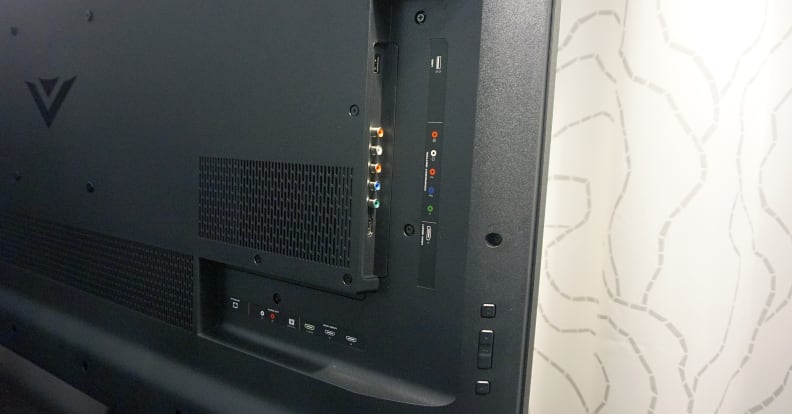
Credit: Reviewed.com / Lee Neikirk
While information technology'due south not a huge issue, the East Series simply has ane HDR-uniform HDMI input, something buyers should be aware of.
There's also the issue of zone count and VA versus IPS console types. Because each of the 2017 E Series models employ FALD (full-array local dimming), the efficacy of their picture quality is highly dependent upon the "zone count," or how many independently controllable LED zones the backlight uses. Traditionally, FALD TVs are very expensive, but the E Serial' claim to fame is delivering FALD at affordable prices. Notwithstanding, to do this, Vizio usually expends the minimum possible amount of effective FALD zones. While a flagship FALD-equipped Telly might accept hundreds of zones, the Due east Series traditionally has somewhere effectually 12.
Each of the E Series TVs delivers iv HDMI inputs, also equally component/composite and USB inputs. Note that none of the East Series displays have internal tuners, and thus you won't get a coaxial/RF jack here. It'due south as well worth noting that but one HDMI input (HDMI 1) is HDMI 2.0 compatible.
Con: Not too piece of cake on the eyes
One major mainstay of Vizio'southward Eastward Series that seems to never change? The pattern. Every twelvemonth, the Eastward Serial look about the same: plain black chassis, stand, and bezels, where by far the most interesting "design" element is the screen. The 2017 version isn't breaking whatever molds, either. However, this is merely a con if you desire a specially handsome TV. If you'd rather not pay for extraneous looks, the Due east Serial' affordability is due in function to how plainly/simply information technology is designed.
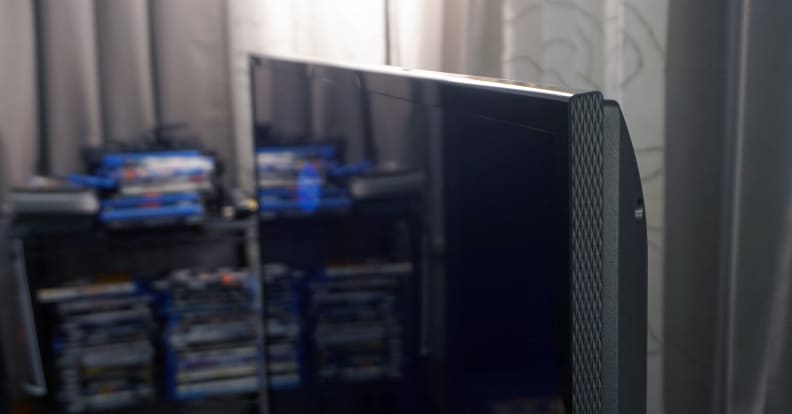
Credit: Reviewed.com / Lee Neikirk
With its black bezels, black caltrop feat, plasticky cease, and thick profile, the E Series isn't going to win whatever awards for design. But that'due south okay.
Pro: For full general viewing, the picture quality is quite expert.
Like previous E Series TVs, the 55-inch 2017 model gets the task done in a compression. Its full-array local dimming may be a bit coarse (more on that in a 2nd), but overall it does accomplish the intended upshot of increasing the E Series' dissimilarity (the darkness of its shadows and brightness of its highlights).
Using the standard ANSI checkerboard and the Calibrated Night mode, I measured an average black level of 0.03 with a reference brightness around 125. This gives the E Series a contrast ratio effectually 4,200:1, which is great for this cost/full-blooded.

Credit: Reviewed.com / Lee Neikirk
Overall, the East Series carries on the tradition of delivering notably good picture quality for its price range. (note: HDR content pictured)
Con: When is an HDR TV not an HDR Idiot box?
This isn't the first time I've had this complaint and information technology won't be the last, but buyers demand to understand the various means in which High Dynamic Range (HDR) matters and doesn't matter. While a TV doesn't need to be super brilliant and colorful for viewers to benefit from the on-board HDR-enabling tech, it's non unreasonable to expect that your "loftier dynamic range" TV take, yous know, more dynamic range than what you're used to seeing. If a Boob tube is going to promise more brightness and a greater range of colors, it needs to deliver.
Your E Series may not stream HDR content still, just a firmware update is on the way.
Because information technology's a FALD-equipped model, information technology has the capability to go fairly bright without introducing unsightly edge-bleed or flashlighting, but it but doesn't. Its colour production range, while definitely expert enough for the majority of non-HDR content, lacks the punching power to actually drop any jaws. While this isn't a blotch confronting the Television necessarily, it'due south something buyers (and HDR fans) should keep in listen: you're non going to be super-duper impressed by Blu-ray HDR here, though it does look very skillful.
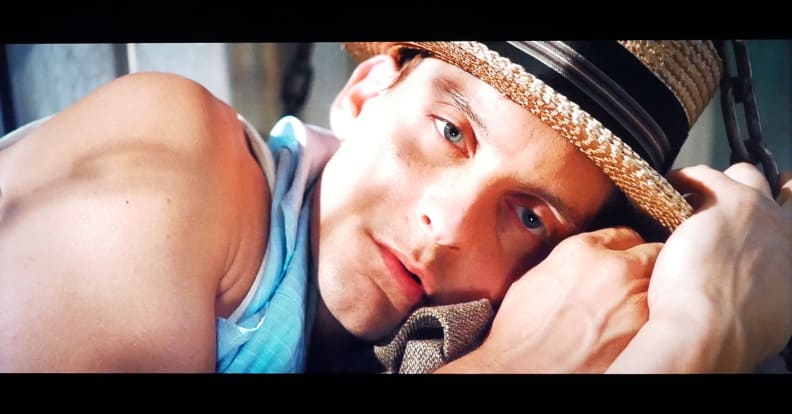
Credit: Reviewed.com / Lee Neikirk
The E Series isn't the about impressive HDR Television set on the market place, but HDR Blu-rays even so wait proficient, even if they aren't jaw-dropping.
The other issue is HDR streaming. We purchased our model and at its current firmware version, information technology couldn't stream HDR content. In this price range, that'southward a scrap of an issue. Unless yous already ain an expensive HDR Blu-ray actor, or a newer game console like the Xbox Ane S, streaming HDR via apps like Netflix and Amazon Video are your best bets to experience the upper echelon of content.
Nosotros spoke with Vizio, notwithstanding, and the company confirmed that a firmware update is on the way to permit for HDR streaming. To evidence it, the visitor pushed the firmware update directly to our E Series model via the serial number, enabling HDR streaming from Netflix, Fandango, and VUDU. And indeed, after the update I was able to stream Marco Polo in HDR on the Idiot box. Eureka!
Con: Smart Cast seems similar such a expert idea on paper.
When Vizio announced the "Smart Cast" platform last year, nosotros were pretty excited. The company's Google cast-based platform saw the 2016 M Series and 2016 P Series aircraft with included Android tablets. This is because Vizio's "Smart Cast" lineup requires a second screen device to exist controlled or used at all.
The East Series can't be set up without the presence of a second screen device.
The 2017 Eastward Serial is in the same boat. Correct on the back of the Tv set near the power cord, in that location'southward a sticker warning users that they won't exist able to set up/utilize the Idiot box without a 2nd screen device. While the 2017 E Series does include a remote command, the intention is that you'll operate information technology entirely via a smartphone or tablet. And on paper, this sounds slap-up. It makes it much easier to do things like type in your WiFi password, and you tin can cast any Google bandage-compatible app directly to the screen.
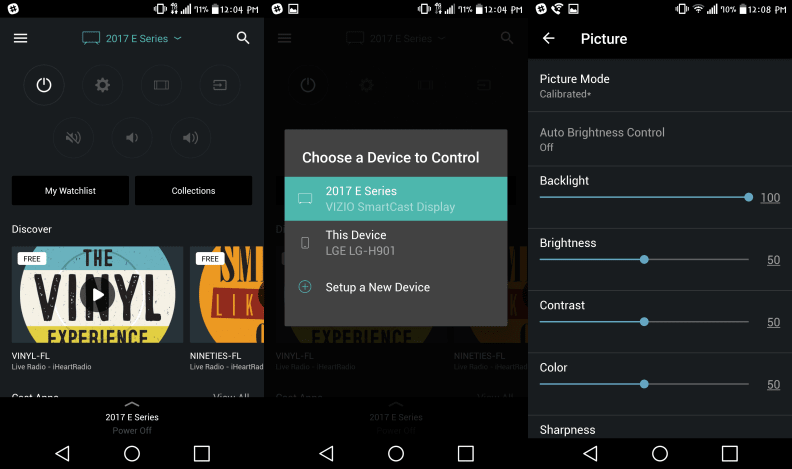
Credit: Reviewed.com / Lee Neikirk
Vizio's SmartCast app is an innovative add-on—when it works. Half the time, it may seriously frustrate you.
Yet, in practice, using the SmartCast app is a bit of a hassle. Setting up and updating our East Serial sample proved to exist a longer process than setting upward a non-Smart Cast TV due to disconnects betwixt the app and the TV. Essentially, I had to go through the entire setup process twice due to the app completely forgetting the connection that had been established.
Con: No built-in tuner means no coaxial devices.
1 interesting matter about the E Series is that the TVs don't comprise built-in OTA tuners. That means they don't have a coaxial/RF input, and y'all won't be able to tune to over-the-air or digital channels, nor utilise an external antenna or satellite. While this doesn't hateful you can't use a cable box with an HDMI or component output to watch cable, it does mean the Television receiver itself primarily cannot be using for "tuning." Not a huge con in 2017, simply something buyers should be aware of.
You can't use any device requiring a coaxial or RF input—the Tv set doesn't have one.
Pro: For a low zone count, this is the best local dimming I've seen in a while.
Something I noticed that's a real feather in the 2017 East Series' cap (or at the very to the lowest degree, the 55-inch we tested): this is some of the best local dimming I've seen on a Television set that purportedly only has 12 dimming zones. Whether I was looking at circuitous test patterns or actual content, the E Series never once showed a hint of unsightly blooming or coarse transitions. Kudos, Vizio.
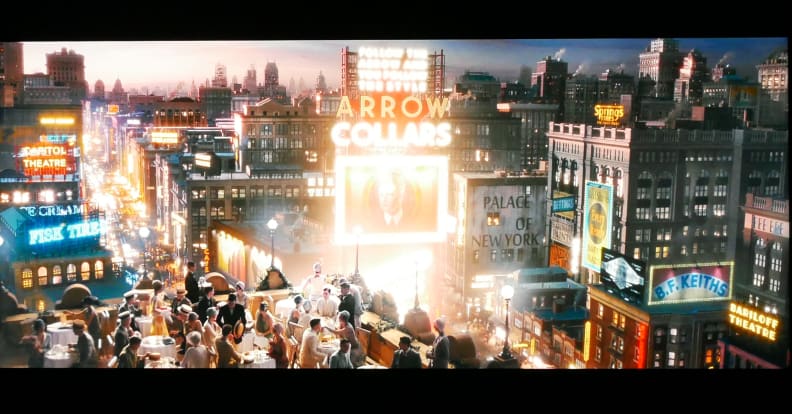
Credit: Reviewed.com / Lee Neikirk
For having such a depression zone count, the 2017 E Series does an splendid job avoiding the usual blooming/flashlighting or slow dimming zone movements of its forebears. (HDR content pictured)
Con: Every bit usual, better contrast comes at the toll of a limited viewing angle.
The large advantage to VA-panel based LED/LCD TVs with full-assortment local dimming (near regardless of zone count) is that, during head-on viewing, they typically deliver much deeper/richer shadow tones and black levels than non-FALD counterparts. The downside? That efficacy falls off quickly during off-angle viewing, making for express horizontal viewing angles.
Case in indicate: I measured a viewing angle that dropped to 16% of the head-on contrast value at merely ten degrees off angle. More plainly, that means you take a very express cone of viewing from anywhere as well straight in front of the TV. Yous get a few feet, plenty for 2 or iii people, only we'd strongly recommend against trying to spread out around a room or wall-mounting the E Serial.
Pro: At the finish of the day, HDR content even so looks good.
We've established that the E Series has some red flags when it comes to referring to information technology equally an HDR Tv set. At the time of this review, most Eastward Serial TVs can't stream HDR content, and information technology'south not much brighter or more colorful than a non-HDR set—I measured peaks below fifty-fifty 300 nits, which most non-HDR TVs tin do simply fine.

Credit: Reviewed.com / Lee Neikirk
Occasionally, red/yellowish/orange content looks a bit skewed, peculiarly the many pare tones in Gatsby, but overall the E Serial does a lot of practiced with the relatively limited palette it boasts.
But I accept to mitt it to the Eastward Series, despite its technical shortcomings where brightness is concerned, it looks groovy. This may exist a credit to the mastering of HDR discs, merely I was impressed. The Eastward Series only has one HDR-friendly HDMI input, and then make sure y'all become the right one before judging on your own.
But suffice to say, despite its 60 Hz refresh rate and limited operation power, the HDR content I watched looked balanced, bright, aptly colored, and attractive. The E Series does a very good chore with what ability it does take to aggrandize on the lite/color space of its standard dynamic range performance, and (unless you're comparing it to a much more than expensive HDR set) won't disappoint.
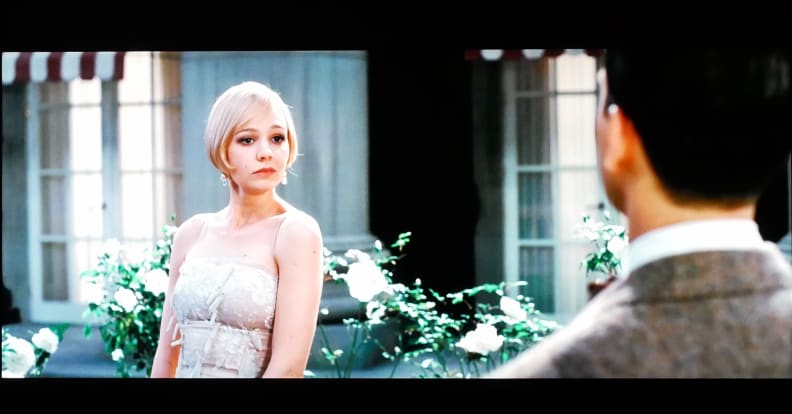
Credit: Reviewed.com / Lee Neikirk
Despite its scattering of shortcomings, HDR off of HDR Blu-rays looks expert here, even if it's not every bit bright/colorful equally on other models.
Yep—just be aware yous aren't getting the "cut border"
On paper, the E Serial checks off a lot of the correct boxes. Information technology's a 4K/HDR/smart TV with a flashy new "Google bandage" organization that uses your second screen device as a remote. How futuristic!
In reality, SmartCast is sometimes a hurting in the butt—not to mention the app likes to randomly pop up and give you the status of the Telly when you're away from it, and sometimes won't connect at all when you're correct next to information technology. The E Series is also not the heaviest hitter from a effulgence/color volume standpoint (nosotros expect the 2017 Thou and P Series volition modify that).
That said, for the things you are getting—the 55-inch gives you 4K resolution, the ability to enjoy HDR content, and smart functionality that is fine when it works—it all the same feels like a serious deal for the request price of $550. The series once more lives upward to its reputation, and we imagine it's going to make an excellent choice for many TV lovers.
See the tester

Lee Neikirk
Editor, Home Theater
@Koanshark
Lee has been Reviewed's bespeak person for nearly television and home theater products since 2012. Lee received Level 2 certification in TV calibration from the Imaging Science Foundation in 2013. As Editor of the Dwelling Theater vertical, Lee oversees reviews of TVs, monitors, soundbars, and Bluetooth speakers. He besides reviews headphones, and has a groundwork in music performance.
Checking our piece of work.
Our team is here for one purpose: to assist you lot buy the best stuff and love what you own. Our writers, editors, and lab technicians obsess over the products we embrace to make sure you lot're confident and satisfied. Have a different stance nigh something we recommend? Email us and we'll compare notes.
Shoot u.s. an email
Source: https://www.reviewed.com/televisions/content/vizio-e-series-2017-tv-review
0 Response to "Vizio 4k Ultra Hd E Series 43 Inch Review"
Post a Comment